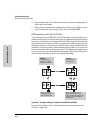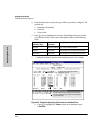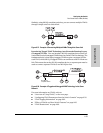
6-51
Configuring the Switch
Port-Based Virtual LANs (VLANs)
Configuring the Switch
Port-Based Virtual LANs (VLANs)
A VLAN is a group of ports designated by the switch as belonging to the same
broadcast domain. (That is, all ports carrying traffic for a particular subnet
address would normally belong to the same VLAN.) Using a VLAN, you can
group users by logical function instead of physical location. This helps to
control bandwidth usage by allowing you to group high-bandwidth users on
low-traffic segments and to organize users from different LAN segments
according to their need for common resources.
The Switches 1600M/2424M/4000M/8000M enable you to configure up to 30
port-based, 802.1Q-compatible VLANs. The 802.1Q compatibility enables you
to assign each switch port to two or more VLANs, if needed, and the port-based
nature of the configuration allows interoperation with older switches that
require a separate port for each VLAN.
General Use and Operation. Port-based VLANs are typically used to
enable broadcast traffic reduction and to increase security. A group of net-
work users assigned to a VLAN form a separate traffic domain; packets are
forwarded only between ports that are designated for the same VLAN. Thus,
all ports carrying traffic for a particular subnet address should be configured
to the same VLAN. Cross-domain broadcast traffic is eliminated and band-
width is saved by not allowing packets to flood throughout the network. An
external router is required to enable separate VLANs to communicate with
each other.
For example, referring to figure 6-35, if ports 1 through 4 belong to VLAN_1
and ports 5 through 8 belong to VLAN_2, traffic from end-node stations on
ports 2 through 4 is restricted to only VLAN_1, while traffic from ports 5
through 7 is restricted to only VLAN_2. For nodes on VLAN_1 to communicate
with VLAN_2, their traffic must go through an external router via ports 1 and 8.


















